ADATA XPG V1.0 Low Voltage Review: 2x8 GB at DDR3L-1600 9-11-9 1.35 V
by Ian Cutress on December 6, 2013 2:00 PM ESTCPU Real World
As mentioned previously, real world testing is where users should feel the benefits of spending more on memory. A synthetic test exacerbates a specific type of loading to get peak results in terms of memory read/write and latency timings, most of which are not indicative of the pseudo random nature of real-world workloads (opening email, applying logic). There are several situations which might fall under the typical scrutiny of a real world loading, such as video conversion/video editing. It is at this point we consider if the CPU caches are too small and the system is relying on frequent memory accesses because the CPU cannot be fed with enough data. It is these circumstances where memory speed is important, and it is all down to how the video converter is programmed rather than just a carte blanche on all video converters benefitting from memory. As we will see in the IGP Compute section of this review, anything that can leverage the IGP cores can be a ripe candidate for increased memory speed.
Our tests in the CPU Real World section come from our motherboard reviews in order to emulate potential scenarios that a user may encounter.
USB 3.0 Copy Test with MaxCPU
We transfer a set size of files from the 120GB OCZ Vertex3 connected via SATA 6 Gbps on the motherboard to the 240 GB OCZ Vertex3 SSD with a SATA 6 Gbps to USB 3.0 converter via USB 3.0 using DiskBench, which monitors the time taken to transfer. The files transferred are a 9.2 GB set of 7539 files across 1011 folders – 95% of these files are small typical website files, and the rest (90% of the size) are precompiled installers. In an update to pre-Z87 testing, we also run MaxCPU to load up one of the threads during the test which improves general performance up to 15% by causing all the internal pathways to run at full speed.
Results are represented as seconds taken to complete the copy test, where lower is better.

The Copy Test shows little difference - only 0.5 seconds between 2400 C11 and 1600 C9.
WinRAR 4.2
With 64-bit WinRAR, we compress the set of files used in the USB speed tests. WinRAR x64 3.93 attempts to use multithreading when possible, and provides as a good test for when a system has variable threaded load. WinRAR 4.2 does this a lot better! If a system has multiple speeds to invoke at different loading, the switching between those speeds will determine how well the system will do.
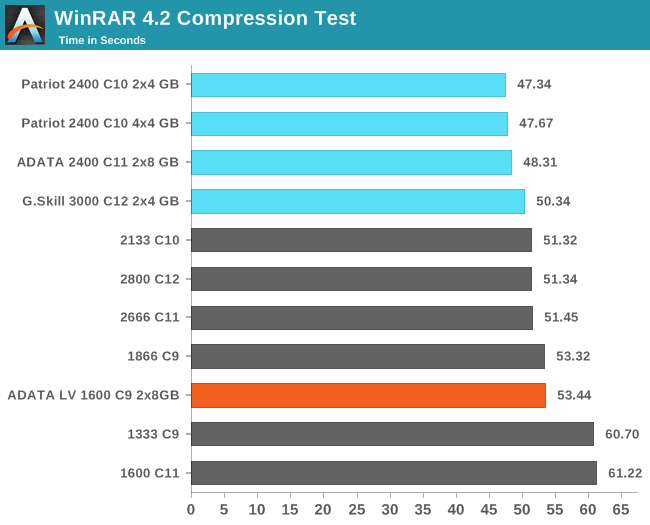
WinRAR is usually the benchmark that shows the biggest difference between the memory kits, and the ADATA LV is some 6 seconds off the pace. The hole of 1333 C9/1600 C11 is avoided.
FastStone Image Viewer 4.2
FastStone Image Viewer is a free piece of software I have been using for quite a few years now. It allows quick viewing of flat images, as well as resizing, changing color depth, adding simple text or simple filters. It also has a bulk image conversion tool, which we use here. The software currently operates only in single-thread mode, which should change in later versions of the software. For this test, we convert a series of 170 files, of various resolutions, dimensions and types (of a total size of 163MB), all to the .gif format of 640x480 dimensions. Results shown are in seconds, lower is better.

FastStone shows memory indifference.
Xilisoft Video Converter 7
With XVC, users can convert any type of normal video to any compatible format for smartphones, tablets and other devices. By default, it uses all available threads on the system, and in the presence of appropriate graphics cards, can utilize CUDA for NVIDIA GPUs as well as AMD WinAPP for AMD GPUs. For this test, we use a set of 33 HD videos, each lasting 30 seconds, and convert them from 1080p to an iPod H.264 video format using just the CPU. The time taken to convert these videos gives us our result in seconds, where lower is better.
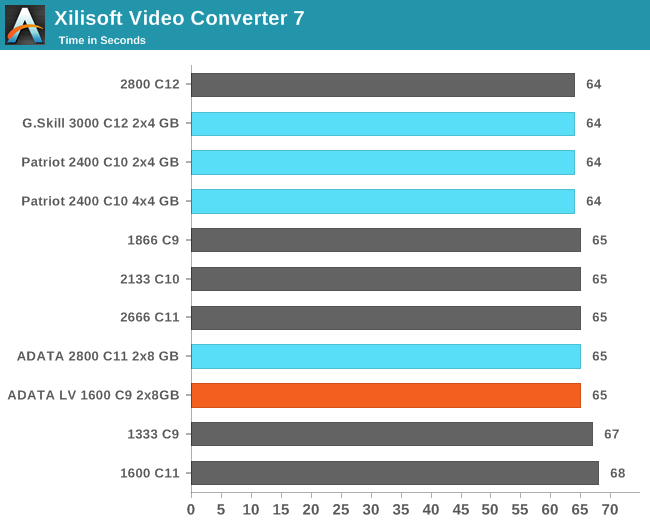
XVC shows WinRAR like differentiation on a smaller scale, with <5% coverall all memory speeds. That might matter for large conversion projects.
Video Conversion - x264 HD Benchmark
The x264 HD Benchmark uses a common HD encoding tool to process an HD MPEG2 source at 1280x720 at 3963 Kbps. This test represents a standardized result which can be compared across other reviews, and is dependent on both CPU power and memory speed. The benchmark performs a 2-pass encode, and the results shown are the average frame rate of each pass performed four times. Higher is better this time around.
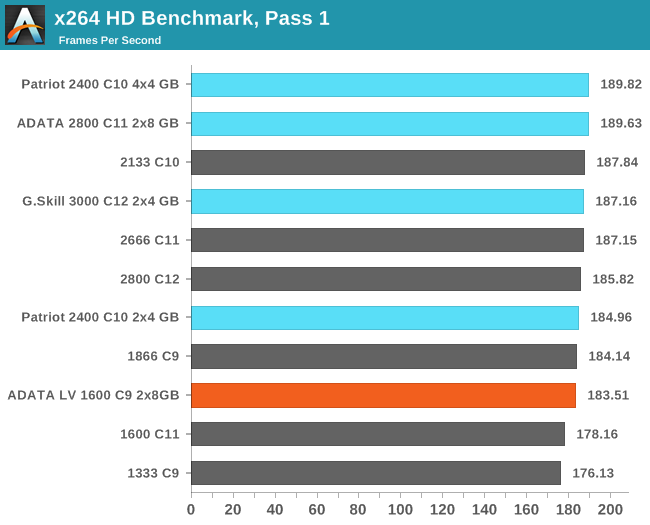
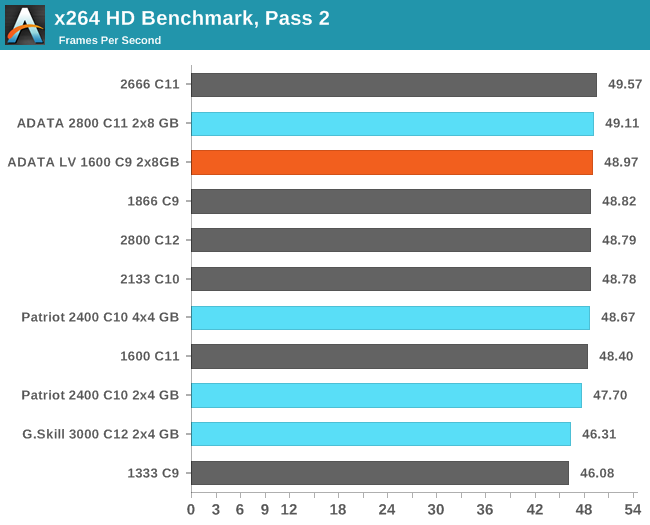
Same story with x264 as with XVC, except we see a reversal of fortunes with pass 2. As pass 2 is optimised after pass 1, it all depends if a second pass is needed. In the comments of some reviews, it seems some of our readers only perform the single initial pass, where the high end memory is ~3% faster than the ADATA LV.
TrueCrypt v7.1a AES
One of Anand’s common CPU benchmarks is TrueCrypt, a tool designed to encrypt data on a hard-drive using a variety of algorithms. We take the program and run the benchmark mode using the fastest AES encryption protocol over a 1GB slice, calculating the speed in GB/s. Higher is better.
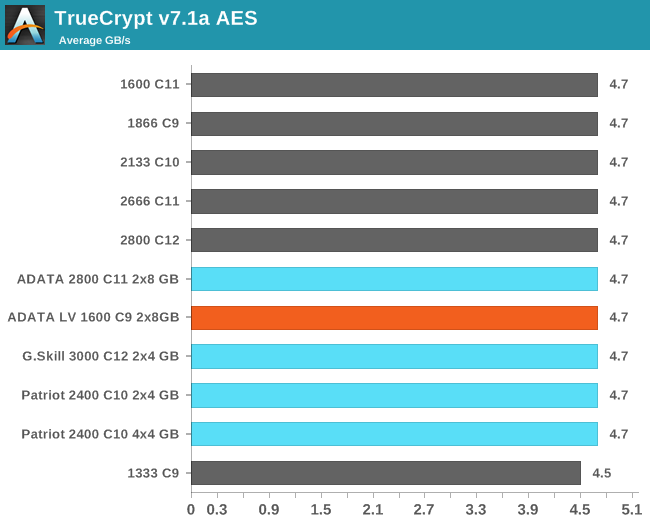










35 Comments
View All Comments
azazel1024 - Friday, December 6, 2013 - link
Can't really argue most of the points.However, I find it mildly useful. I have a 2x4GB kit in my server, which is on nearly 24/7 (Task scheduler pulls it down to S3 from 1am back awake at 6am, because no one is ever awake to use it them).
I can run it at 1.2v since it is a G1610 Celeron, so only 1333mhz and its a G.Skill Sniper 1.25v DDR3 1600Mhz kit. Lowest I could go before was a single DIMM 4GB 1.5v module I could run at 1.4v before things got wonky.
Difference between the two DIMMs at 1.2v and 1.5v though is around 1.5W at idle on my kill-a-watt and around 2-3w when hitting the server with a heavy load. Not much, but it is a bit of green ePeen for me, and the thing does run close to 24x7. Sure, its still probably only $2 a year, but I am hoping to get several years out of the machine or at least the memory.
My desktop has 1.35V CAS9 kit in it, 4x4GB Mushkin DDR3 1600 kit. The advantage there is it'll run at 1866Mhz CAS10 and 1.38v stable. It was cheaper than any 2x8GB kits on the market at the time and actually slightly cheaper than any 4x4GB DDR3 1866 kits.
Case temp is a degree lower at 1.38v than at 1.5v and it also runs about 4w less under load.
It isn't much, but I pride myself on having low(ish) power setups, as well as running as quiet and cool as I can, plus especially the 16GB kit in my desktop, it was actually cheaper to get the LoVo memory and upclock it to 1866Mhz than it was to get a native 1866Mhz kit at the time.
The Von Matrices - Friday, December 6, 2013 - link
You make a very good point that I never though of before.S3 sleep still provides power to refresh the memory. If you are like me and never shut down your computer (instead using sleep) then your memory is consuming energy 24/7 no matter how infrequently the computer is powered on.
If you don't use your computer a lot but do use sleep, then the memory could account for a significant portion of the computer's overall energy consumption.
gamoniac - Sunday, December 8, 2013 - link
I have my server running 24x7, too, but the saving here is really not that significant. Basically, accidentally leaving a 60-watt light blub on over night would undo months of saving gained from this low-voltage RAM.ShieTar - Tuesday, December 10, 2013 - link
You're supposed to replace those bulbs by 10-watt LEDs as well ;-)It's not always about the current saving potential. Sure, 1W of 24/7 usage is only 2$ to 3$ of savings, depending on where you live, today. But with the increasing number of customers and constant or decreasing sources for electricity, it makes sense for us as a civilization to invest into power-saving technologies. So the low-voltage RAM is a fundamentally good Idea, and if the combined cost of Hardware and Electricity is comparable to normal-voltage modules, it makes plenty of sense to buy them. Even if you don't save enormous amounts of money right now, at least this module can now become the new baseline if everybody goes for it.
MrSpadge - Sunday, December 8, 2013 - link
During sleep the data in memory is refreshed, but I'm pretty sure there is no clock signal supplied, so it's not actually working. Hence power consumption should be significantly lower than running normally, I gues by about 1 to 2 orders of magnitude.JoannWDean - Saturday, December 14, 2013 - link
my buddy's aunt earned 14958 dollar past week. she been working on the laptop and got a 510900 dollar home. All she did was get blessed and put into action the information leaked on this site... http://cpl.pw/OKeIJoCygni - Friday, December 6, 2013 - link
What about heat? The real target market for these seems to be people (like me) interested in making true silent high performance PCs. Because its nearly 2014 and it's time to stop putting leaf blowers on the side of your case to play a video game.I would be interested in seeing what difference the voltage makes, and the comparison to the other kits.
BigLeagueJammer - Friday, December 6, 2013 - link
Here's an article with tests performed by Puget Systems:http://www.pugetsystems.com/labs/articles/Technolo...
The conclusion they found was that the lower voltage RAM made a 1-2 degree difference in CPU temperatures. That's not huge, but if you're striving for a really quiet build, it could help make it little bit more quiet.
MrSpadge - Sunday, December 8, 2013 - link
Playing a game you probably have a CPU+Mainboard+RAM drawing about 100 W, and a GPU drawing at least 100 W. Now subtract 1 to 2 W from low voltage RAM from this and you get less than 1% difference. This won't be audible even in direct comparisons.extide - Friday, December 6, 2013 - link
Regarding Low TDP CPU's.A lot of people don't seem to realize that Low TDP CPU's are basically the exact same thing as a regular TDP chip, except they don't turbo as much, hit as high freq/etc.
The point is a 84W i7 4770 will idle down just as low as a 35W i7-4765T, for example. It is only when the CPU is fully pegged that the lower TDP actually makes a difference.
For a normal desktop user, just browsing the internet/etc, this means that a 84W chip vs a 35W chip will make almost no difference, especially if they are the exact same configuration. (quadcore vs dualcore, same number of EU's in the graphics, etc) The CPU is idle/clocked down via speed step/etc most of the time anyways.
Back in the day, there used to be a bigger difference as the low-TDP chips had the same clocks and performance as the regular ones but ran on less volts. Back then, those low power chips were great. These days the low TDP ones typically run in similar voltage ranges, and whatnot but essentially their ability to reach into the higher ranges (voltage, clockspeed, etc) is significantly reduced. They are basically the exact same chips. There may be some mild binning involved, but if you really want a good-binned CPU for low power then you will probably need to get a mobile/laptop chip.
So basically unless you are running F@H or something, a T or S series CPU is really pointless. Unless you are an OEM, and NEED to strictly adhere to some thermal limit due to a small cooler or something, I see almost zero reason to go for a T/S series CPU, ES{ECIALLY when they typically cost more!
I see lots of people using T/S series cpu's in things like PC-based routers. That is a prime example of a place where it is pointless to do so, because the cpu will be idle 99% of the time anyways, and a normal TDP chip can clock/volt down just as much as a low tdp chip.
Just some food for thought. Sorry, it is a tiny bit off-topic with regards to the actual article, but you do mention power savings and low TDP chips in there.